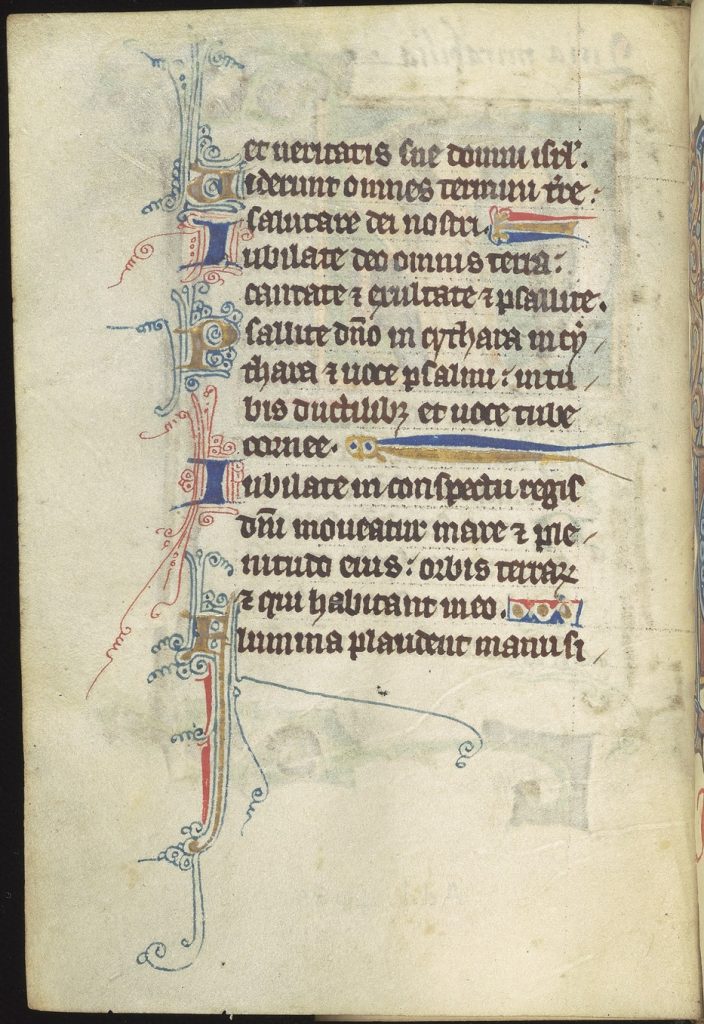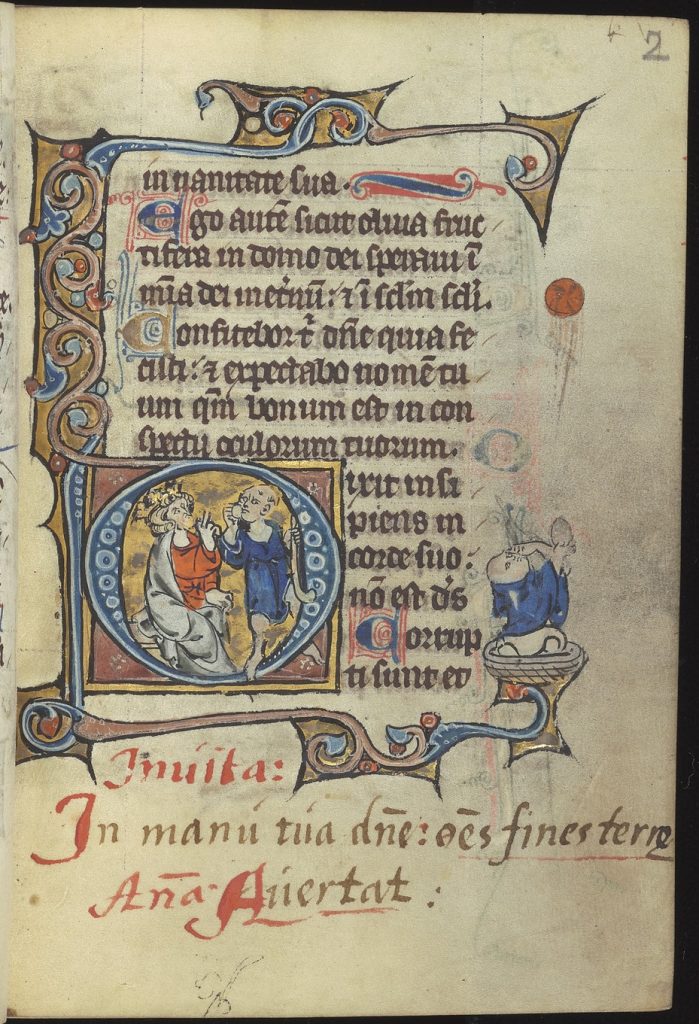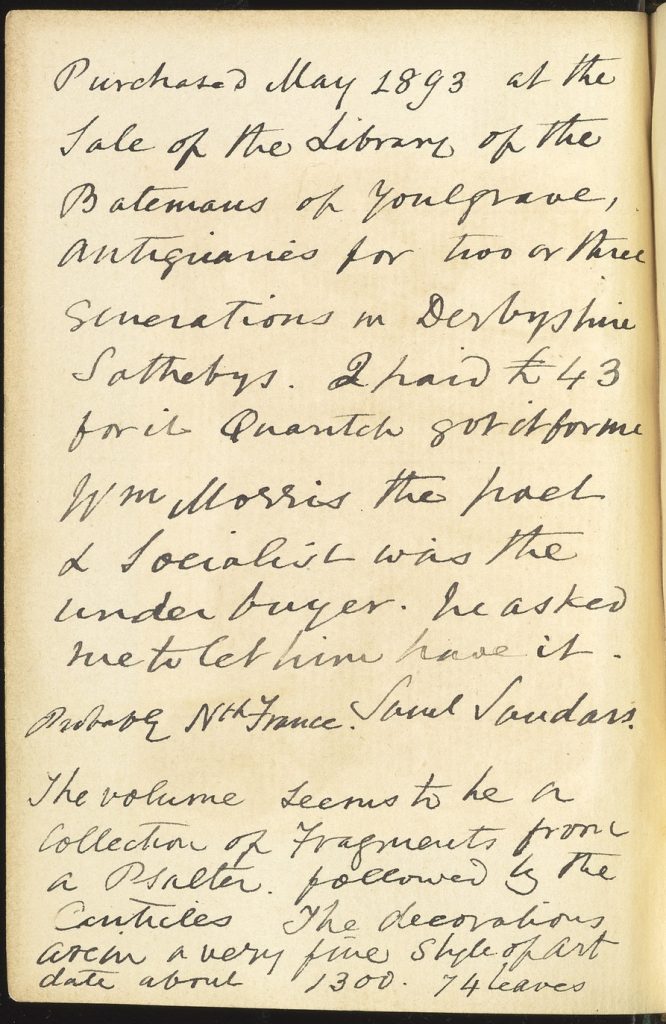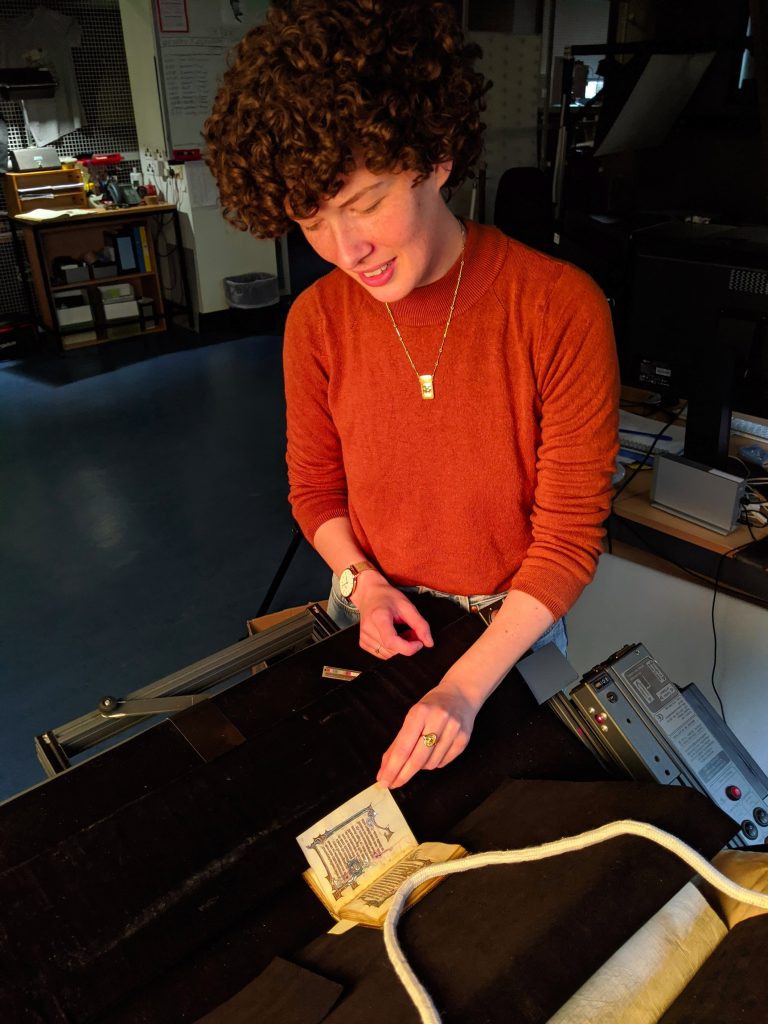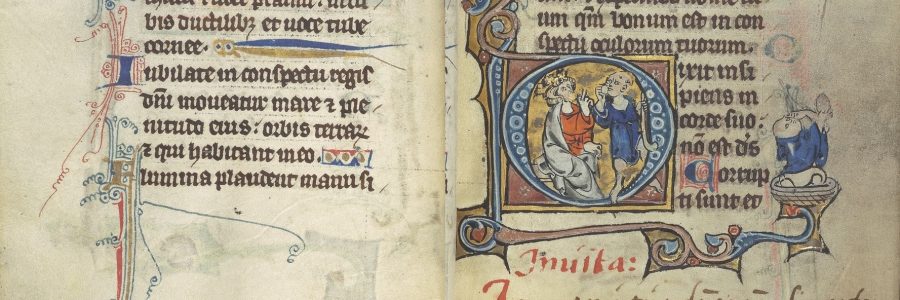
A little manuscript in disarray: Add. 4085
This guest post is by Suzette van Haaren, a PhD student at the Universities of St Andrews and Groningen. She is writing her dissertation on the effects of digitisation for the reproduction, perception and preservation of medieval manuscripts. Follow her on Twitter @suzettevhaaren.
Though at first glance CUL MS Add. 4085 does not look like anything unusual, this little psalter manuscript may be the strangest book I have ever worked with. Nothing is out of the ordinary with its beautifully executed decorations or pen work initials that lace the text throughout, nor is there anything remarkable about its text per sé. But if you look closer the text of folio 1 does not comply with the text on folio 2: confusingly, it jumps from psalm 97 to psalm 51. The same goes for the folia that follow. The 74 leaves that make up Add. 4085 – now available in full on the Cambridge University Digital Library – all taken from the same early fourteenth-century psalter, are bound in complete disorder. Someone in likely the eighteenth or nineteenth century cut up, mixed, and rebound the most interesting folia from the original psalter.
A curiosity for study and amusement
In the late eighteenth and ninetieth centuries the study of medieval books was dominated by enthusiasts who saw medieval manuscripts, particularly illuminated manuscripts, as curiosities of a foregone era. Wielding a knife to create smaller samplers, fragmenting entire books, was not at all out of the ordinary. Single leaves were sold as ‘miniature paintings’, elaborate albums or collages of medieval decoration were made, and books were re-created as the ‘extra-illustrated volume’.[i] Completely new objects were made with original medieval material. Our little psalter fell prey to this trend. The result is an amazing manuscript book, where none of its psalms or canticles are legible anymore, but each page is splendidly decorated with marginal imagery aplenty. Unfortunately, the cutter probably also excised much information about the psalter’s original medieval production process. It is thought to have been made in French Flanders around 1300, based on the decoration which bears similarity to Cambridge Trinity College MS B.11.22.[ii] The binding, green tooled morocco, is of the early nineteenth century, from the workshop of James Hayday. Whether Hayday is our mixing culprit is not certain: it could easily have come to him in this form, and he simply rebound it as it was given to him. The decorated psalter leaves were not only kept for appreciation from a distance; the manuscript was also actively used to study the forms and style of fourteenth-century manuscript illumination. On certain folia there clearly is a pencil tracing of the decoration on the other side shining through. We can imagine someone sat at their desk, Add. 4085 opened in front of them, tracing on its parchment the lines and curves of the decoration that shines through the thin membrane.
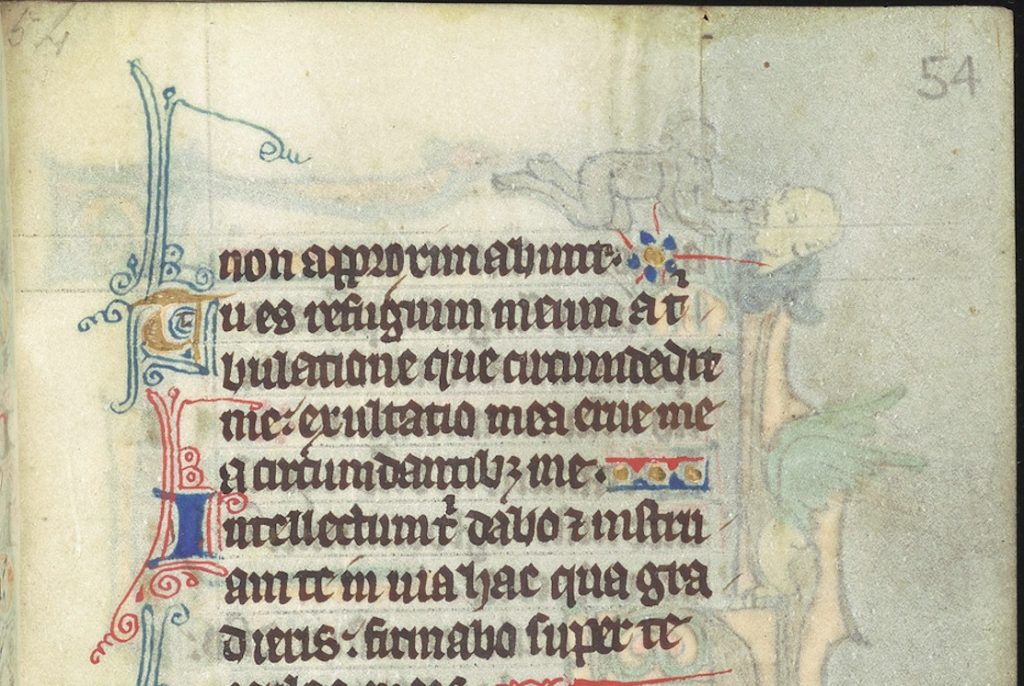
Nineteenth-century collectors
Add. 4085 was bought in 1840 for Thomas Bateman’s collection of medieval manuscripts and rare books. The coat of arms of the Bateman family is displayed on the pastedown. Bateman (1821-61), antiquary and amateur archeologist, had a particular interest in medieval decoration. Interestingly, an album with fragments from Bateman’s collection (now Cambridge UL, Add. 4166), holds a tracing on paper of an Old English prayer or creed. Rebecca Rushforth suggests that Bateman himself traced the medieval script, not only to study the text but because of his interest in the form of the script.[iii] It would not be so strange, then, to imagine Bateman transferring his tracing habits to this manuscript. The practice would certainly accord with his elevated interest in medieval forms. When Bateman died in 1861 he left his book collection to his son. Unfortunately, the younger Thomas did not share his father’s enthusiasm and sold the books to pay off his debts, including Add. 4085.[iv] The little manuscript, described in the catalogue of the sale at Sotheby’s in London on 30 May 1893 as ‘[…] a charming specimen of taste in illumination […]’, caught the eye of two prominent men in nineteenth-century collecting.[v] Both Samuel Sandars, best known as benefactor to Cambridge University Library, and William Morris, ‘the poet & socialist’, were interested in buying. In an inscription on the flyleaf we read that eventually Sandars paid £43 for it. He snatched the manuscript from under Morris’ nose, who was the under-buyer and had asked Sandars to ‘let him have it.’ Morris was famously taken with medieval decoration, praising medieval manuscript illumination for its extraordinary beauty and the invention of the ornament. To him, these specimens were the ultimate example of the pre-industrial ideal of arts and crafts that he so vehemently promoted.[vi] Instead of Morris’ private collection, Add. 4085 was bequeathed to the University Library in 1894 upon Sandars’s death.
Disarray in the midst of disarray — digitisation and ordering
When I chose this manuscript for digitisation, I did not expect many difficulties to arise. It is only a small manuscript with relatively few leaves to be photographed. The photographs were made by the photographers in the Digital Content Unit at the University Library. When I looked through the high-resolution images, nothing appeared out the ordinary: I saw the folia as they were, in complete disarray with no logical sequence. It was only when I started describing the Add. 4085 in the standard XML-TEI format that I realised the disarray in the disarray. Somewhere in the list of image files there were two images missing, which meant that all the images in between the two were jumbled up. Even though it often seems the work of technology, digitisation is largely the work of people — people who sometimes make mistakes. After some afternoons in the Manuscript Reading Room, comparing the book with the list of images on my screen, I found out the correct incorrect order. This meant going back to the photographers to shoot the additional photographs and re-sequence the images. What we see on our screens now, is the disarray as intended by the early manuscript scholar, not the accidental disarray by the modern digitisation specialist.
Now Add. 4085 is fully available online on the Cambridge University Digital Library, which means it is open for a new kind of manuscript enthusiast. Luckily, re-mixing the manuscript in digital space is a little less destructive to the original medieval object. Let us all wield our digital knives and make fragments, share the curious images on social media and make GIFs out of them! On the other hand, the digital format also allows for the recombination of the images. I am planning to re-organise the digital Add. 4085 in its correct order of folia from the original fourteenth century psalter. Perhaps the strange disarray of the little manuscript will appear even more strange when its leaves are re-ordered some two centuries after it was cut, mixed and rebound.
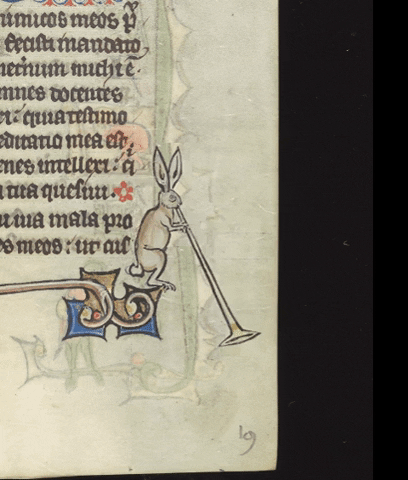
[i] Hindman, Camille, Rowe, and Watson, eds. Manuscript Illumination in the Modern Age: Recovery and Reconstruction (Evanston, Illinois, 2001) 52-62, 69-101.
[ii] Binski and Zutshi, Western illuminated manuscripts: a catalogue of the collection in Cambridge University Library, ed. Stella Panayotova (Cambridge; New York: Cambridge University Press, 2011), no. 370, 342-343; Ringrose, Summary catalogue of the additional medieval manuscripts in Cambridge University Library acquired before 1940 (Woodbridge: Boydell & Brewer, 2009), 136-137. About B.11.22, see James, The Western Manuscripts in the Library of Trinity College, Cambridge: a Descriptive Catalogue (Cambridge University Press, 1902 (or.), 2009), no. 261, 365-373.
[iii] Rushforth, ‘The Barrow Knight, The Bristol Bibliographer, and a Lost Old English Prayer’. Transactions of the Cambridge Bibliographical Society 12, no. 4 (2003): 372–374.
[iv] Rushforth 2003, 374-375.
[v] The Bateman Heirlooms: Catalogue of the Valuable Library of Printed Books & Manuscripts (London: Dryden Press, 1893), lot 1304.
[vi] Hindman o.a. 2001, 173-174.

